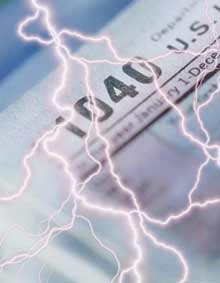

People who are laid off or entering retirement often find that a former employer’s retirement plan can be an unwelcome place to keep their money. Layoff notices are often followed with a deadline to withdraw retirement assets from the company plan because the employer is no longer willing to bear the cost. People who have retired may find that their former employer’s plan doesn't offer the flexibility or investment options they need to pursue their post-retirement goals.
Fortunately, there is an alternative: By rolling retirement assets into an IRA, it’s possible to preserve their tax-deferred status. When a rollover to a traditional IRA is performed correctly, there should be no tax consequences, no tax penalties, and, in most cases, no out-of-pocket expense to the account owner.
Federal tax law allows for more than one way to execute a rollover. But did you know it’s possible to do it legally and still run into complications which can include having to come up with a large cash payment? Once you leave a job, your employer’s retirement plan administrator may send you paperwork to begin the process of moving your retirement money out of the plan. You are likely to be given the option of simply receiving a check made out in your name. You then have 60 days to deposit the check in a traditional IRA. This is what's known as an indirect rollover, and although it sounds easy — two months is plenty of time to open an IRA — an indirect rollover can get dicey.
Double Jeopardy: The Withholding Trap
If the plan administrator makes the check out in your name, it is required to withhold 20% of the rollover amount, for the same reason your employer withheld a portion of your pay: in anticipation of income taxes.
Even though you are conducting a transaction that does not have any intended tax consequences, the IRS doesn’t trust you to follow through. You might decide to spend all or part of the money. You could miss the 60- day deadline. You might deposit the check in the wrong type of account. Any one of these actions would be considered a taxable event and you could incur an income tax liability (plus a 10% federal income tax penalty if you are younger than age 59½).
For example, let’s say that you have $100,000 in your former employer’s 401(k) plan, and you advise the plan administrator that you wish to conduct an indirect rollover. A week or so later, you get a check in the mail for $80,000. In order to successfully execute this rollover, you need to deposit $100,000 in a traditional IRA within
60 days. If you don’t have the extra money to make up the difference, you will owe ordinary income taxes on $20,000 plus a $2,000 penalty if you are younger than 59½.
You may be able to prevent the employer plan from withholding 20% by having the check made out to the new IRA custodian. But most experts would tell you that you are still leaving an unnecessary margin for error whenever the money from an IRA rollover passes through your hands.
Ed Slott, a certified public accountant who has written a number of books on IRAs, is one such expert. Slott recommends conducting a direct rollover, a hands-free transaction sometimes known as a trustee-to-trustee transfer. Under this arrangement, the plan administrator transfers the funds directly to the IRA custodian. There is no withholding and, if the transfer to a traditional IRA is properly executed, there are no tax consequences or penalties, regardless of your age.
If you have retirement funds in one or more former employer plans, rolling them into an IRA can help prevent you from losing track of any of your money. Plus, it can help ensure that you have the greatest number of investment options available and can monitor the overhead costs.
We can help you conduct a direct rollover and greatly reduce the potential for mistakes that result in an unplanned tax liability or costly tax penalties. Call us for help.
UGEN PEDEN